1- DJI Mini 4 Pro (Overall Winner):
DJI Mini 4 Pro Fly More Combo Plus with DJI RC 2, Mini Drone with 4K HDR Video, 3 Intelligent Flight Battery Plus for up to 135 Mins Flight Time, Smart Return to Home, Drone with Camera for Beginners
This compact powerhouse packs a serious punch. It boasts high-resolution photos and videos, obstacle avoidance for stress-free flying, and a long battery life, making it ideal for both beginners and seasoned flyers. Weighing less than 250 grams, it eliminates the need to register with the FAA in the United States.

DJI Mini 4 Pro: A Mighty Mini with Perks and Quirks
The DJI Mini 4 Pro takes the crown as the king of sub-250g drones, but it’s not without its compromises. Here’s a breakdown of the pros and cons to help you decide if it’s the perfect fit for your aerial adventures.
Pros:
Ultra-portable champion: Weighing in at just 249 grams, the Mini 4 Pro remains exempt from drone registration in most regions. This makes it incredibly travel-friendly and allows for more spontaneous flying.
Surprisingly powerful: Don’t let the mini size fool you. The Mini 4 Pro boasts a larger sensor (compared to the Mini 3 Pro) and excellent image quality, even in low light. It shoots stunning 4K video at up to 100 fps for impressive slow-motion capture.
Safety first: The Mini 4 Pro steps up the safety game with omnidirectional obstacle avoidance. This advanced sensor system helps you steer clear of bumps and crashes, giving you more peace of mind while flying.
Master of tracking: ActiveTrack 360° keeps your subject locked in the frame, even during complex maneuvers. This makes it fantastic for capturing dynamic action shots or following along with a moving object.
Cons:
Battery blues: The sub-250g weight limit comes at a cost – shorter flight time. The base battery offers a maximum of 34 minutes, which might feel limiting for some users.
Price bump: Compared to the Mini 3 Pro, the Mini 4 Pro carries a higher price tag. You’re essentially paying for the improved camera, obstacle avoidance, and some other features.
Not quite zoomtastic: While the image quality is great, the Mini 4 Pro lacks a dedicated zoom lens. This might be a concern for pilots who need to get closer to their subjects without physically moving the drone.
Overall Winner?
The DJI Mini 4 Pro stands out as the most capable sub-250g drone on the market. If portability and ease of use are your top priorities, and you value the extra safety features and image quality, then the Mini 4 Pro is the clear winner. However, if budget is a major concern, or you require a longer flight time and don’t mind sacrificing some features, the Mini 3 Pro might be a better choice.
In conclusion, the DJI Mini 4 Pro is a powerful and portable drone that pushes the boundaries of what a sub-250g drone can achieve. Just weigh the pros and cons to see if it lands the perfect balance for your needs.
2- DJI Air 3 t All-Rounder:
DJI Air 3 Fly More Combo with DJI RC 2, Drone with Camera 4K, Dual Primary Cameras, 3 Batteries for Extended Flight Time, 48MP Photo, 20Km Max Video Transmission, FAA Remote ID Compliant
The Air 3 strikes a perfect balance between affordability, features, and performance. It delivers superb image quality, obstacle avoidance for assured flight, and impressive battery life, catering to both photography and videography enthusiasts
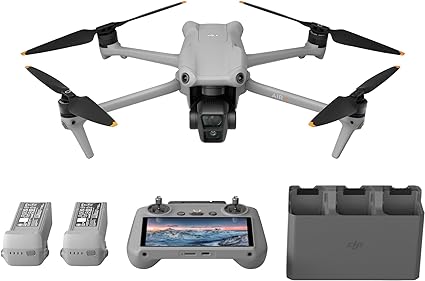
The DJI Air 3t has earned its reputation as a versatile “All-Rounder” drone. It offers a good balance of portability, image quality, and intelligent features. However, like any drone, it has a few drawbacks to consider:
Bulkier Design: Compared to the ultra-light Mini 4 Pro, the Air 3t is heavier and less portable. While still under the 250g weight limit, it might not be as convenient for travel or slipping into a backpack.
Battery Life: While decent, the Air 3t’s battery life doesn’t quite match some competitors. This could be a concern for pilots who require longer flight times for complex projects or extensive travel.
Thermal Sensor Limitations: The thermal sensor, a key feature for the Air 3t, might not be as sophisticated as those found on higher-end thermal drones. Professionals relying on high-precision thermal imaging for tasks like inspections or search and rescue might find it lacking.
Price Point: The Air 3t falls into a higher price bracket compared to some beginner or hobbyist drones. This is understandable given its advanced features, but budget-conscious flyers might find it a pricier option.
Overall:
The DJI Air 3t is a solid choice for pilots who need a versatile drone with a good balance of features and flight performance. However, if portability or affordability are top priorities, or if you require the most advanced thermal imaging capabilities, then there might be better options available.
3-DJI Mavic 3 Pro (Premium Pick):
The undisputed king of the DJI castle, the Mavic 3 Pro boasts unrivalled image quality, the longest battery life of the bunch, and the most advanced features on the market. This premium option caters to professionals and serious hobbyists seeking the absolute best.

The DJI Mavic 3 Pro reigns supreme as the “Premium Pick” for a reason. It boasts a powerful Hasselblad camera system, impressive flight time, and intelligent features for professional-grade content creation. However, its premium status comes with a few drawbacks:
Cost: The biggest hurdle for many will be the Mavic 3 Pro’s price tag. It’s significantly more expensive than many other drones on the market, making it a serious investment for casual users.
Size and Weight: While foldable for portability, the Mavic 3 Pro is bulkier and heavier than some sub-250g options. This might be a concern for pilots who value extreme portability or who need to comply with stricter weight regulations in certain areas.
Limited Third-Party App Support: As of now, there’s no official Software Development Kit (SDK) available for the Mavic 3 series. This means you might miss out on the flexibility and customization offered by popular third-party drone control apps.
Telephoto Cameras (Hasselblad Name Clarification): While the dual telephoto lenses offer impressive zoom capabilities, they don’t share the full Hasselblad name recognition and associated benefits of the main camera.
Overall:
The DJI Mavic 3 Pro is a phenomenal drone for professional content creators and experienced pilots who demand the absolute best. However, its premium price, size, and lack of full third-party app support make it a less ideal option for budget-conscious users or beginners who prioritize portability. If you can afford the investment and require top-of-the-line features, the Mavic 3 Pro is a worthy contender. Otherwise, it might be wise to consider other models that offer a better balance of price, portability, and capability.
4- DJI Mini 3 (Budget King):
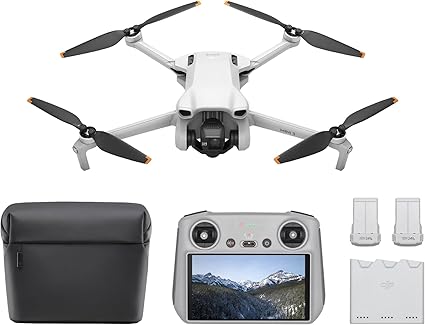
The DJI Mini 3 takes the crown as the “Budget King.” It offers impressive features for its price point and stays comfortably under the 250g weight limit, making it travel-friendly. However, being king of the budget category comes with a few compromises:
Image Quality: While good for everyday use, the Mini 3’s sensor size is smaller compared to pricier models. This can translate to slightly less detail and potential for noise in low-light conditions.
Wind Performance: Due to its lightweight design, the Mini 3 might struggle in strong winds compared to heavier drones. This could lead to less stable footage or difficulty flying in certain weather conditions.
Obstacle Avoidance: Unlike some of its DJI siblings, the Mini 3 lacks advanced obstacle avoidance sensors. Pilots need to rely more on manual control and visual line-of-sight to navigate safely.
Battery Life: While decent, the Mini 3’s battery life doesn’t quite match some competitors. This could be a concern for pilots who require longer flight times for complex projects or extensive travel. Purchasing additional batteries can help mitigate this.
Overall:
The DJI Mini 3 is an excellent choice for budget-conscious flyers who prioritize portability and ease of use. It captures stunning visuals in most lighting conditions and offers a good balance of features for the price. However, if you require top-notch image quality in low light, exceptional wind resistance, or advanced obstacle avoidance, then you might need to consider upgrading to a more premium model
5- DJI Avata 2 FPV:
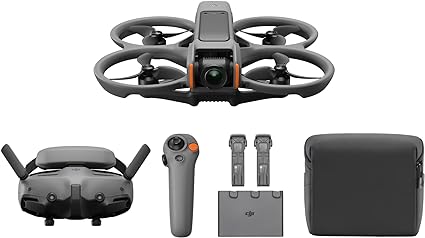
The DJI Avata 2 FPV dives headfirst into the world of first-person view (FPV) flight, offering an exhilarating flying experience with its compact cinewhoop design and high-quality footage. However, this high-flying experience comes with a few limitations to consider:
FPV Learning Curve: While DJI has made FPV more accessible with the Avata 2, mastering FPV flight still requires practice and prior drone experience. It’s not as intuitive as flying traditional DJI camera drones.
Limited Remote Control Options: Unlike some other DJI models, the Avata 2 has limited remote control options. You’ll need to purchase a separate DJI FPV remote controller or DJI Goggles series product for operation, adding to the overall cost.
No Obstacle Avoidance: The Avata 2 prioritizes maneuverability and a clear view for FPV flight, sacrificing obstacle avoidance sensors found on many DJI drones. Pilots need to be extra cautious and rely solely on visual line-of-sight to avoid crashes.
App Compatibility: The Avata 2 doesn’t use the standard DJI Fly app. It requires a separate DJI Avata Fly app, which might limit some features and functionalities familiar to DJI users.
Repairs and Customization: The Avata 2’s unique design can make repairs or customization more challenging compared to traditional DJI models.
Overall:
The DJI Avata 2 is a fantastic choice for experienced pilots and FPV enthusiasts who crave an immersive flying experience with high-quality footage. However, its learning curve, limited remote control options, lack of obstacle avoidance, and app limitations make it less suitable for beginners or those looking for a traditional camera drone with advanced safety features.
6- DJI Mavic 3 Classic:
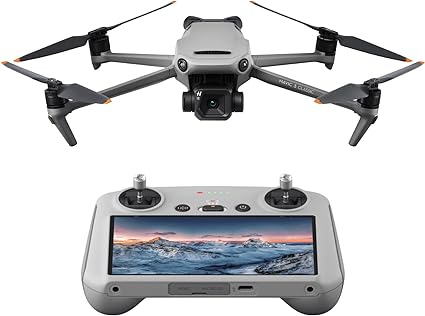
The DJI Mavic 3 Classic carries the torch of a beloved design, offering a familiar form factor with some of the latest DJI camera tech. However, this classic approach comes with a few compromises that potential buyers should consider:
No Telephoto Lens: Unlike its pricier sibling, the Mavic 3 Pro, the Classic version lacks a dedicated telephoto lens. This means zooming in on distant subjects will rely on digital zoom, which can result in a loss of image quality.
Heatsink Limitations: The Mavic 3 Classic uses a passive cooling system compared to the active cooling found in the Mavic 3 Pro. This might limit extended recording times in very hot environments, especially for professional users pushing the drone’s limits.
Battery Life Trade-off: While still offering a good flight time, the Classic model boasts a slightly shorter battery life compared to the Mavic 3 Pro. This could be a concern for pilots who require maximum flight duration for complex projects or long journeys.
Not the Latest and Greatest: Since it retains the Mavic 2 design, the Classic might not have the very newest airframe or motor technology compared to DJI’s latest offerings. This could translate to slightly less efficient flight performance.
Overall:
The DJI Mavic 3 Classic is a compelling option for pilots who prioritize a familiar and reliable design with excellent image quality. It offers a good balance of features and performance at a more attractive price point compared to the top-tier Mavic 3 Pro. However, if you require the best zoom capabilities, the most advanced thermal management, the absolute longest flight time, or the newest DJI technology, then you might be better suited looking elsewhere in DJI’s lineup
7- DJI Air 2S (Oldie But Goldie):

The DJI Air 2S has earned its place as a “Goldie” among drone enthusiasts. It boasts excellent image quality, a compact design, and a good balance of features for the price. However, even a golden oldie can’t escape the sands of time:
Maturing Technology: While still a capable machine, the Air 2S was released in 2021. Newer DJI models might boast more advanced features, camera sensors, or processing power.
Limited Obstacle Avoidance: The Air 2S relies on a forward and downward visual sensor system for obstacle avoidance. This offers some protection, but it’s not as comprehensive as the omnidirectional obstacle sensing found on some newer DJI drones.
No AirSense: This DJI safety feature helps drones detect nearby airplanes and helicopters. The Air 2S lacks this system, so pilots need to be extra vigilant about airspace awareness, especially in busy areas.
Battery Life Could Be Better: Competitors in the Air 2S’s weight class might offer slightly longer flight times. This could be a factor for pilots who require extended recording sessions or need to cover larger areas.
Overall:
Despite its age, the DJI Air 2S remains a fantastic choice for photographers and videographers who prioritize portability, image quality, and a good value. However, if you crave the absolute latest technology, the most advanced obstacle avoidance features, or require the longest possible flight times, then a newer DJI model might be a better fit. The Air 2S is a “Goldie” that holds its value, but it’s important to be aware of the advancements made in the ever-evolving drone market
8– Potensic ATOM 3-Axis Gimbal 4K GPS Drone
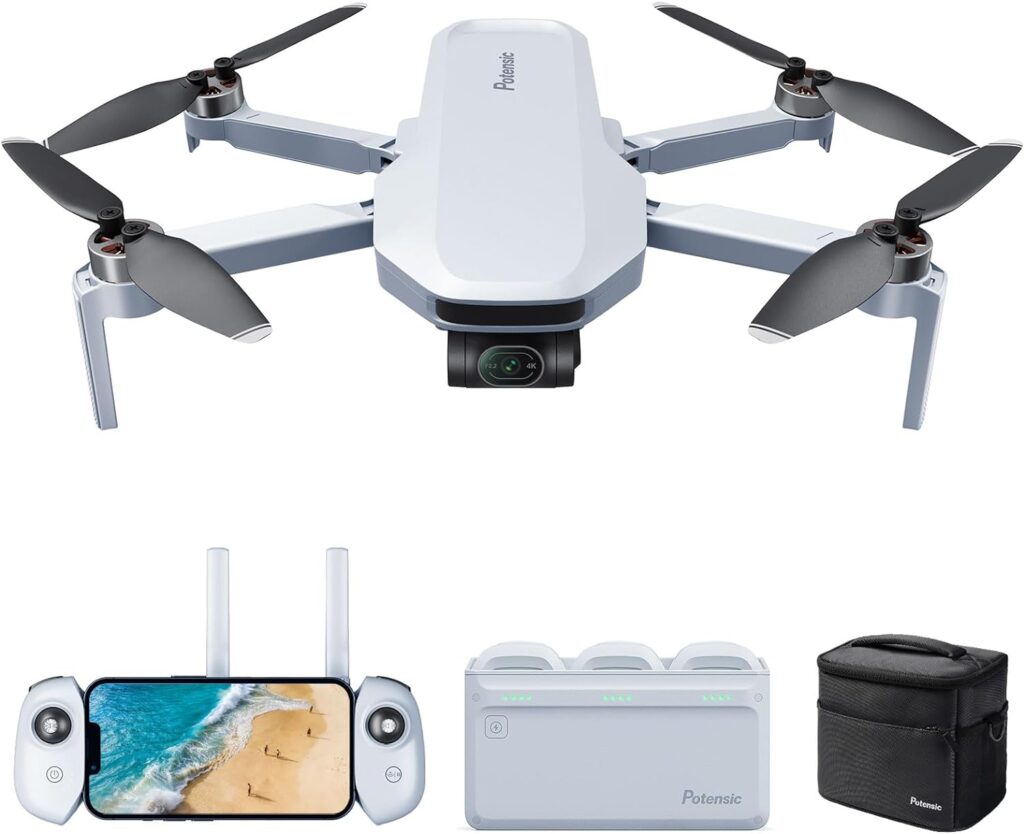
The Potensic ATOM emerges as a tempting budget-friendly choice with a 3-axis gimbal for stabilized footage and a 4K camera for capturing aerial views. However, its affordability comes with some limitations that budget-conscious buyers should consider:
Image Quality Trade-Offs: While the camera boasts 4K resolution, low-light performance might be underwhelming. You might see more image noise and reduced detail in less than ideal lighting conditions.
Fixed-Focus Camera: The ATOM features a fixed-focus camera, meaning you won’t be able to manually adjust focus for close-up shots. This can limit creative control over image composition.
Limited Obstacle Avoidance: Unlike some competitor drones, the ATOM lacks any obstacle avoidance sensors. Pilots need to rely solely on visual line-of-sight to navigate, requiring extra caution and potentially limiting flying in complex environments.
App Dependence: While the ATOM comes with an app for control and viewing, some users report limitations compared to DJI’s user-friendly and feature-rich apps.
Brand Recognition and Support: Potensic, while a growing brand, might not have the same level of brand recognition or established customer support network as some larger drone manufacturers.
Overall:
The Potensic ATOM is a solid option for hobbyists and casual flyers on a tight budget. It offers a taste of 4K aerial photography and the benefits of a stabilized gimbal at a very attractive price point. However, be prepared for limitations in low-light performance, lack of manual focus, and a more basic user experience compared to pricier models. If you prioritize image quality, advanced features, or robust customer support, then you might need to consider investing in a more established brand.
9- DJI FPV Explorer Combo (Goggles Integra)
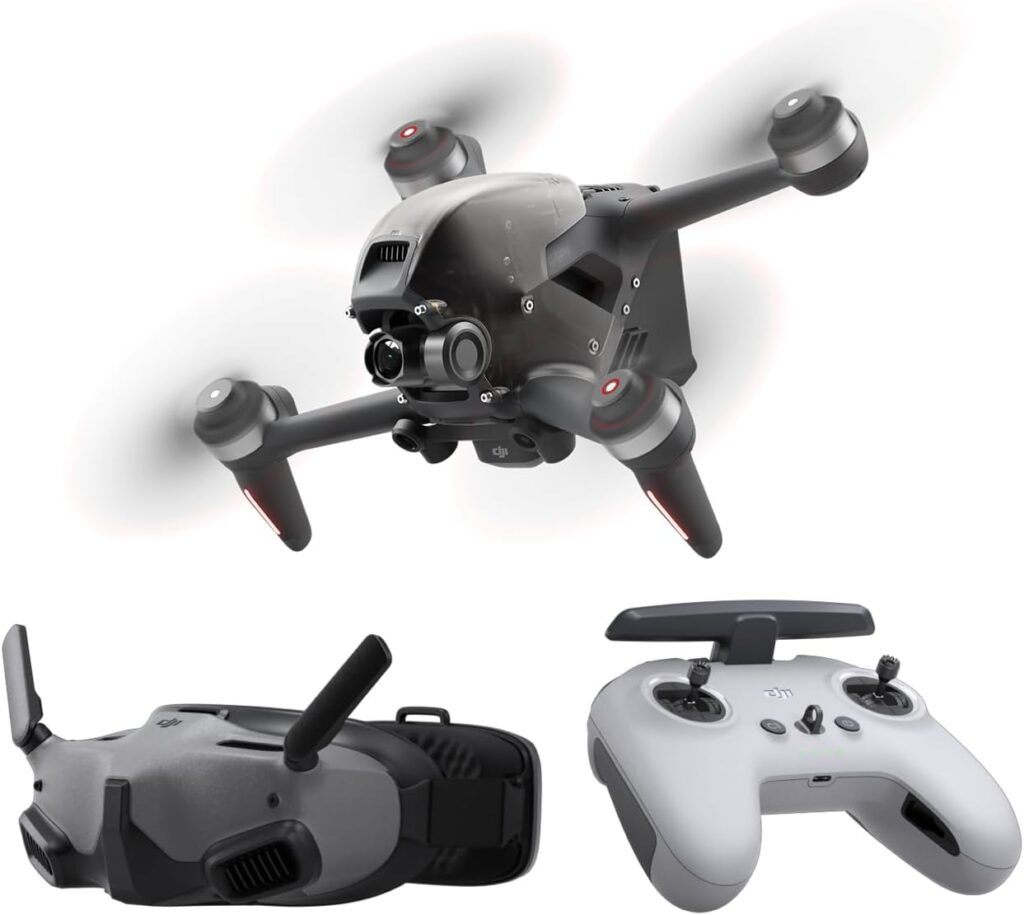
The DJI FPV Explorer Combo (Goggles Integra) unlocks the world of first-person view (FPV) flight with a captivating goggle system and a capable drone. However, this exciting dive into FPV comes with a few limitations to consider:
- FPV Learning Curve: Mastering FPV flight requires dedication and practice, even with DJI’s more user-friendly approach. It’s not as intuitive as flying traditional DJI camera drones.
- Limited Remote Control Options: The Explorer Combo relies on the DJI FPV Goggles Integra for control, sacrificing the versatility of separate remote controllers found in other DJI models. This might limit future upgradeability or options for comfortable long-range flying.
- Bulkier Design: The combination of goggles and drone creates a bulkier package compared to traditional DJI camera drones. This can affect portability and might be less convenient for travel.
- Safety Considerations: The FPV Explorer lacks advanced obstacle avoidance sensors found on many DJI drones. FPV flight inherently requires more focus and spatial awareness from the pilot, so extra caution is necessary to avoid collisions.
- Limited App Functionality: The goggles use a separate DJI FPV Fly app instead of the standard DJI Fly app. This might limit some features and functionalities familiar to DJI users.
Overall:
The DJI FPV Explorer Combo (Goggles Integra) is an excellent choice for pilots intrigued by FPV flight and the immersive experience it offers. DJI’s goggles and flight mode options make FPV more accessible than ever. However, the steeper learning curve, limited control options, bulkier design, and focus on pilot awareness make it less suitable for beginners or those wanting a traditional camera drone with advanced safety features. If you’re ready to embrace the thrill of FPV flight and prioritize the goggle experience, the Explorer Combo is a solid choice. Otherwise, consider a traditional DJI camera drone with a remote controller for a more beginner-friendly introduction to aerial photography.
10- Brushless Motor Drone with Camera-4K
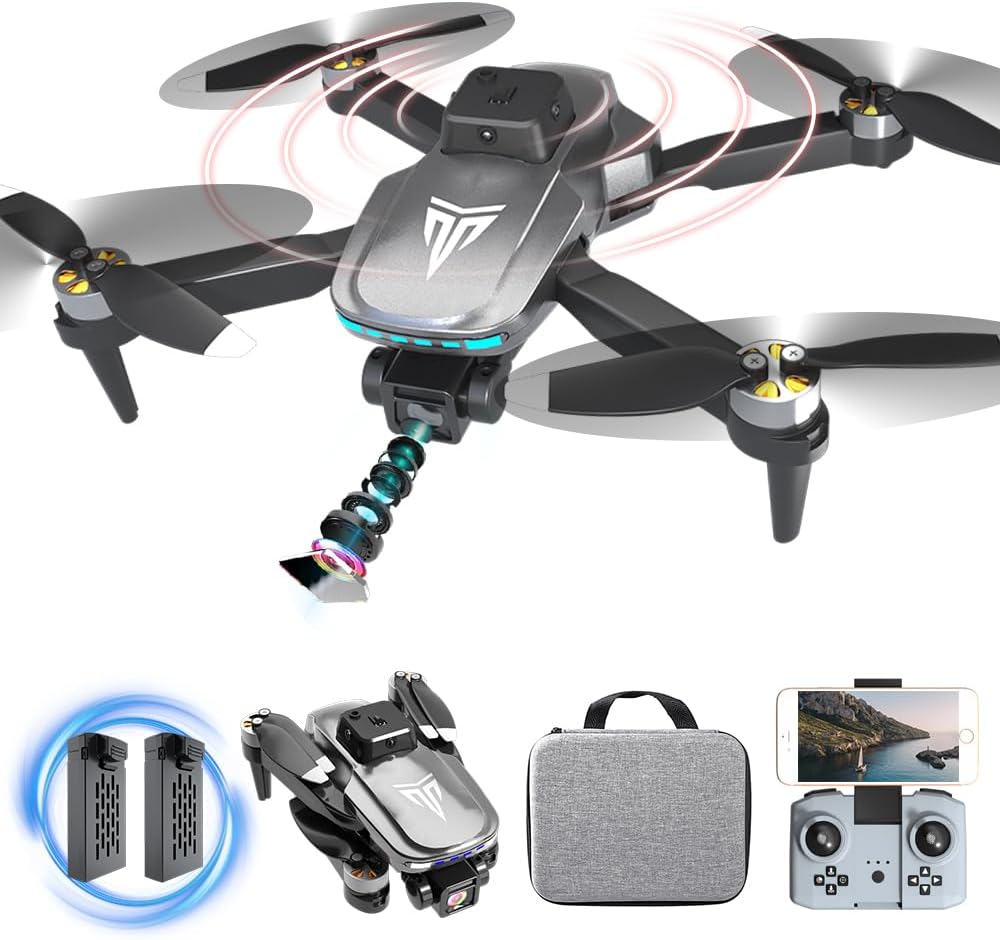
Brushless Motor Drone with Camera-4K: Balancing Price with Performance (But Watch Out for the Wobbles)
The allure of a “Brushless Motor Drone with Camera-4K” at a budget price point is undeniable. Brushless motors generally offer more efficiency and power, and 4K promises high-resolution aerial footage. However, before you take the plunge, here are some potential drawbacks to consider:
Uncertain Brand and Quality: These drones are often sold by generic retailers and lack the brand recognition of established drone manufacturers like DJI or Autel. This can make it difficult to assess quality, reliability, and customer support.
Questionable Image Quality: While the camera might advertise 4K resolution, the actual image quality might be underwhelming. These drones might use lower-quality sensors or lack effective image stabilization, resulting in blurry, shaky, or low-detail footage.
Limited Features and Functionality: Don’t expect the same level of features or flight modes found in pricier models. These drones might have simpler apps, shorter flight times, and lack advanced features like obstacle avoidance or intelligent flight modes.
Durability Concerns: The build quality of budget brushless motor drones might not be as robust as established brands. This could lead to concerns about crashes or damage during flight, especially for beginners.
Limited Support and Replacement Parts: Since these drones are often generic, finding replacement parts or troubleshooting issues might be more difficult compared to established brands with dedicated customer support networks.
Overall:
A Brushless Motor Drone with Camera-4K can be a tempting starting point for budget-conscious flyers. However, be prepared for potential compromises in image quality, features, durability, and overall user experience. If you prioritize high-quality footage, reliable performance, and a user-friendly system, it might be wise to save up for a drone from a reputable brand. Remember, in the world of drones, you often get what you pay for.

